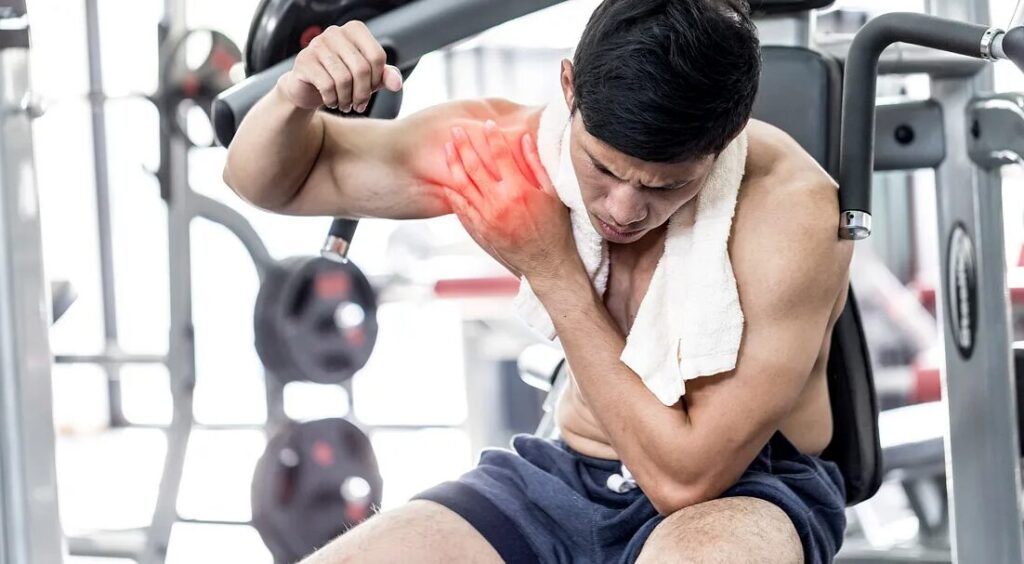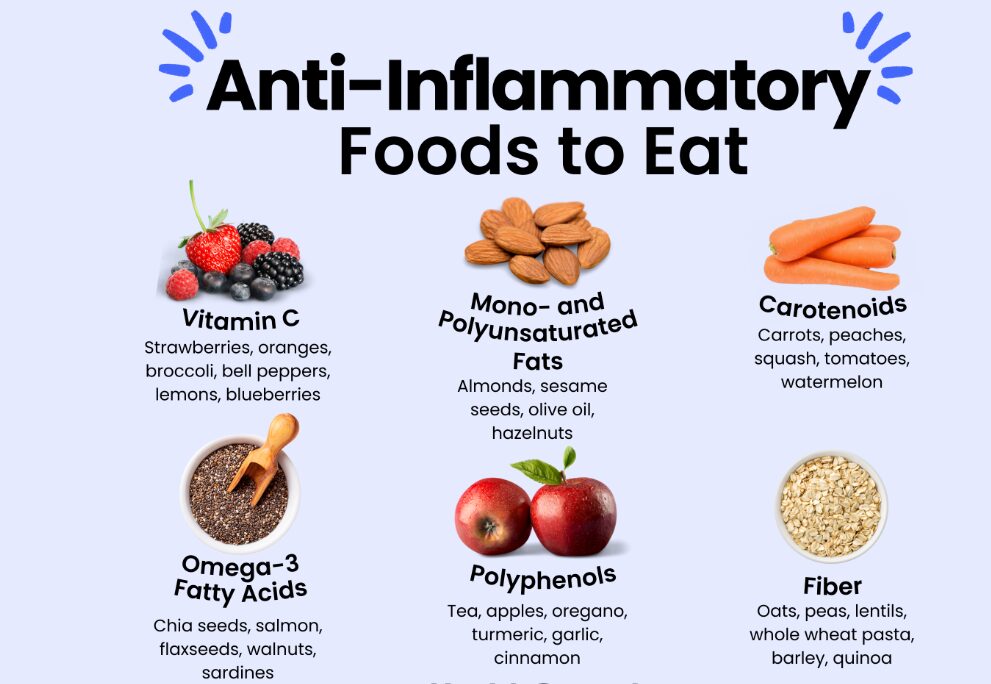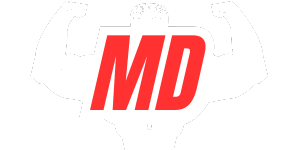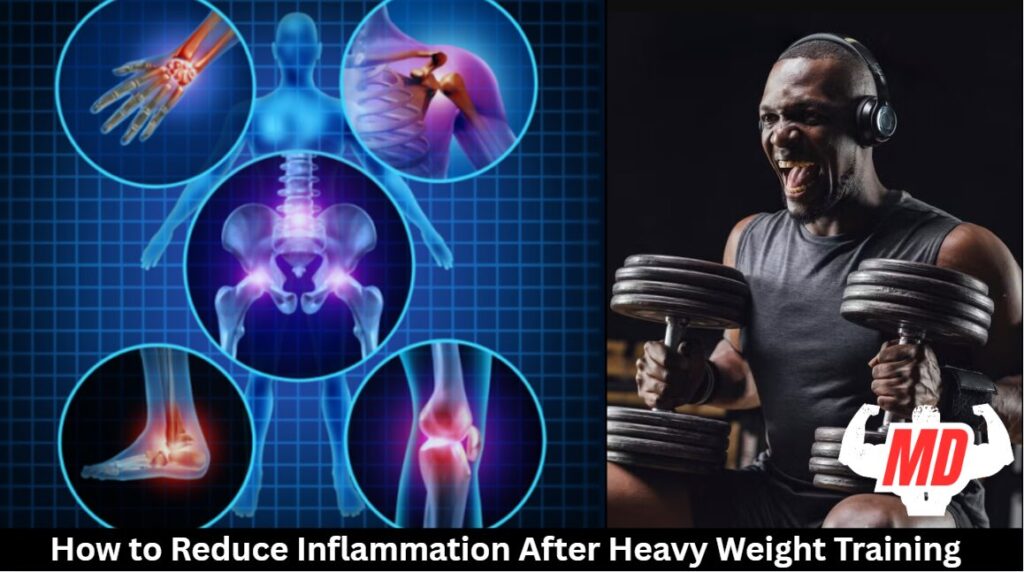To reduce inflammation after heavy weight training, prioritize hydration with 16-24 ounces of water plus electrolytes. Consume a 3:1 carb-to-protein ratio meal within 30 minutes post-workout. Apply cold therapy for 15-20 minutes to sore areas and incorporate anti-inflammatory foods like berries, fatty fish, and turmeric into your diet. Don’t skip your cool-down and stretching routine. Quality sleep is equally vital for your muscles to repair and grow stronger.
Inflammation After Weight Training
When you lift heavy weights, your body immediately launches a sophisticated repair process that begins with inflammation. This natural response creates the foundation for muscle growth, but can leave you feeling sore and stiff. Delayed onset muscle soreness (DOMS) typically peaks 24-48 hours post-workout, signaling that your muscles are adapting and strengthening.
To manage this effectively, focus on incorporating anti-inflammatory foods like berries, fatty fish, and leafy greens into your post-workout nutrition. Strategic use of recovery supplements such as omega-3s and curcumin can further reduce excessive inflammation.
Perhaps most importantly, prioritize rest and sleep quality, as this is when your body performs its most intensive repair work. Balancing the right amount of inflammation is key. Have enough for adaptation without prolonging recovery.

Post-Workout Recovery Fundamentals
Although your workout ends when you rack the weights, your body’s recovery process is just beginning. Prioritizing proper hydration for muscle health immediately after training helps flush inflammatory byproducts from your system. Aim for 16-24 ounces of water with electrolytes to replace what you’ve lost through sweat.
Your post-workout nutrition timing matters. Consume protein and carbohydrates 30 minutes after to kickstart muscle repair strategies. A 3:1 carb-to-protein ratio works well for most lifters.
Don’t skip your gentle cool-down and stretching routine, which helps reduce blood pooling in worked muscles and maintains flexibility. Incorporate active recovery techniques like light cycling or walking to promote blood flow without adding stress. These fundamentals create the foundation for faster recovery and reduced inflammation.
Nutrition to Reduce Inflammation
While post-workout supplements have their place, what you eat daily plays the most significant role in controlling exercise-induced inflammation. Focus on incorporating anti-inflammatory foods and spices like berries, leafy greens, and turmeric into your regular diet.
Omega-3 fatty acids for recovery are particularly effective. These healthy fats help counteract the inflammatory response triggered by intense training.
Your post-training meals that aid recovery should combine protein with antioxidant-rich foods. Try salmon with sweet potatoes and broccoli, or a smoothie with whey protein, cherries, and ginger.
Don’t overlook herbal anti-inflammatories. Include them in your meals to provide cumulative benefits for your recovery process.

Recovery Techniques and Therapies
Beyond nutrition, physical recovery can reduce inflammation after intense weight training sessions. Cold therapies like ice baths and cryotherapy narrow blood vessels to reduce swelling after exercise, and especially after heavy lifting. Cool packs may be applied to sore areas for 15-20 minutes several times daily.
Contrast this with strategic heat therapy, which increases blood flow and muscle relaxation when acute inflammation goes away. Add foam rolling to your routine for maximum heavy lifting recovery tips. Foam rolling breaks up adhesions in muscle tissue, increases circulation, and reduces muscle tension. Spend 1-2 minutes on each major muscle group, focusing on tight areas or painful areas.
With these techniques, you can dramatically accelerate recovery time when done consistently.

Supplements That Support Recovery
Fight post-workout inflammation with physical recovery techniques and strategic supplementation. For weight training recovery, omega-3 fatty acids reduce inflammatory markers following intense sessions. They are available as fish oil supplements or plant alternatives.
Curcumin from turmeric can reduce muscle soreness and DOMS. Try combining it with black pepper extract for better absorption.
BCAAs (branched-chain amino acids) complement your workout recovery meal plan by providing essential building blocks for muscle repair. Taking them before or during training may reduce breakdown and accelerate recovery.
These supplements work best when paired with proper stretching routines and hydration, not as replacements for fundamental recovery practices but as strategic enhancements to your existing regimen.
Lifestyle and Sleep for Reduced Inflammation
Although supplements and recovery techniques are valuable tools in your anti-inflammation arsenal, sleep quality and lifestyle choices form the foundation of effective post-workout recovery. While in deep sleep, your body releases growth hormone and regulates cortisol levels, directly impacting how quickly your muscles repair themselves.
Get up to 9 hours of sleep to create a consistent bedtime routine in a cool, dark room. Manage stress through meditation, deep breathing, or gentle yoga to keep cortisol levels in check. Elevated stress hormones can prolong inflammation and delay recovery.
Don’t underestimate the value of active recovery days. Light activities like walking, swimming, or cycling increase blood flow to damaged muscles without causing additional strain, helping to flush out inflammatory markers.
Frequently Asked Questions
Can Anti-Inflammatory Medications Improve Weight Training Recovery?
You shouldn’t rely on NSAIDs regularly, as they can impair muscle growth. For occasional severe soreness, they’re acceptable, but prioritize natural methods like proper nutrition and adequate rest instead.
How Does Aging Affect Post-Workout Inflammation Response?
As you age, you’ll experience prolonged inflammation after workouts due to decreased hormone levels, slower cellular repair, and reduced enzyme activity. Your recovery demands more attention through improved nutrition, sleep, and targeted recovery techniques.
Does Inflammation Response Differ Between Men and Women?
Yes, women typically experience less inflammation than men due to estrogen’s anti-inflammatory effects. Women often recover faster, though individual factors like fitness level and age still play significant roles.
When Should I See a Doctor About Post-Workout Inflammation?
Consult a doctor if you’re experiencing severe pain, prolonged swelling (over 72 hours), reduced mobility, redness/heat at injury sites, or symptoms that worsen despite rest. Don’t ignore persistent inflammation that interferes with daily activities.
Can Regular Sauna Use Reduce Chronic Training Inflammation?
Yes, regular sauna sessions can help reduce chronic training inflammation. Try 2-3 weekly sessions of 15-20 minutes for ideal anti-inflammatory effects.



